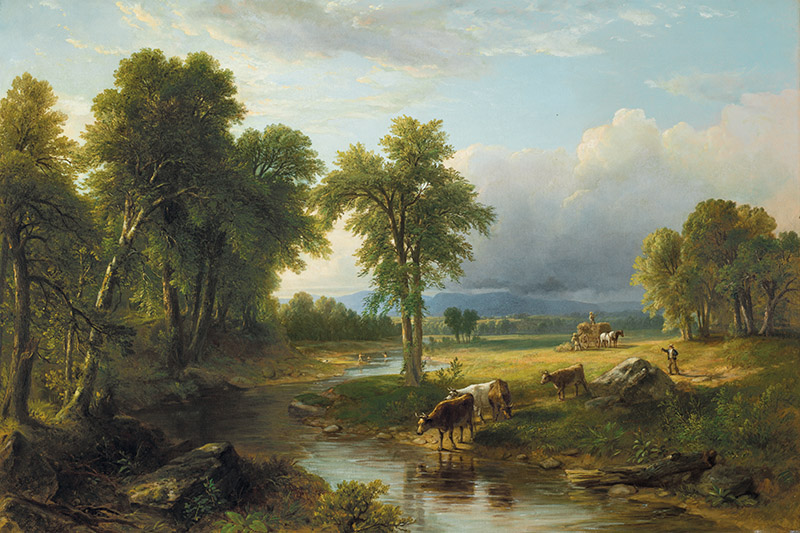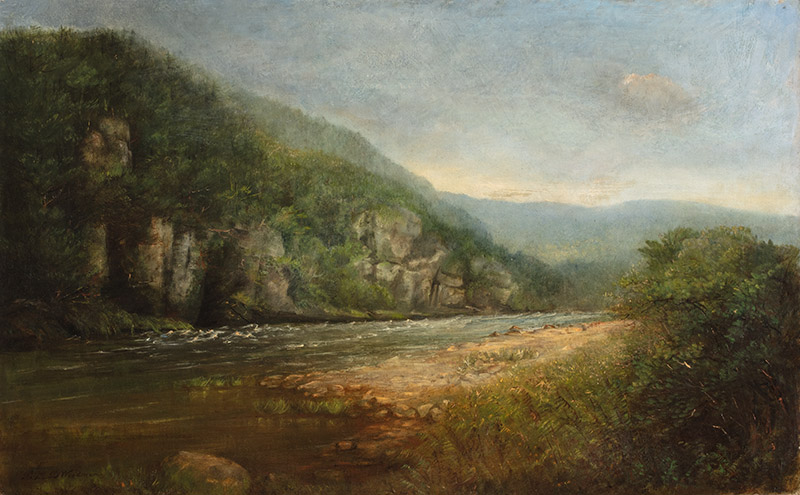Re/Framing the View: Nineteenth-Century American Landscapes
New Bedford Whaling Museum, Wattles Gallery • New Bedford, MA • whalingmuseum.org • Through May 14, 2023
A lake is a landscape’s most beautiful and expressive feature. It is Earth’s eye; looking into which the beholder measures the depth of his own nature.”
—Henry David Thoreau

“A landscape is a mirror and a window,” says curator Naomi Slipp. “Whatever’s happening in the culture determines what a landscape shows—or doesn’t show.”
Slipp is the New Bedford Whaling Museum’s chief curator. The exhibition, Re/Framing the View: Nineteenth-Century American Landscapes, retells the story of American landscape painting via three twenty-first century plot lines: race, gender, and the environment.
This show reminds us that what we see in the mirror of landscape changes with the looking. For example, “from an Indigenous perspective, the genre of landscape painting is one of the conceptual and visceral tools of colonization,” as Cornell artist and scholar Jolene Rickard has said. Volumes of invisible assumptions and priorities determine whether a given mountainside in 2022 will be home to a sacred temple, a terraced farming community, or a toxic cobalt mine for making smartphone batteries and airplane engines, for example.
The work on show is drawn from regional private collections and the museum’s own strong collection, supplemented with a few strategic institutional loans. Included are works by Thomas Cole, the Peale family group, Thomas Eakins, William Bradford, John F. Kensett, Martin Johnson Heade, Frederic Edwin Church, Albert Bierstadt, Jasper Francis Cropsey, George Inness, John William Casilear, Francis A. Silva, Sanford Robinson Gifford, and Robert Seldon Duncanson, among many others.
As the roster suggests, most of nineteenth-century landscapists were men; “capturing the wilderness” was viewed as a masculine pursuit. To underscore the genre’s gendered character, Slipp has included a selection of objects—including china, nature studies in watercolor, and decorative arts—that demonstrate where and how women participated in capturing American flora and fauna.
Additionally, the exhibition ingeniously pairs the work of celebrated male landscapists with work by their wives, daughters, and students, displaying for example not only paintings and prints by Fitz Henry Lane but comparable work by Mary Blood Mellen. More colleague than student, Mellen was among the most accomplished artists ever to work on Cape Ann, and scholars now believe she probably had a hand in some of Lane’s paintings. Her apprentice-like copies of Lane’s works are virtually indistinguishable from the originals (even Lane couldn’t always tell them apart). Other illuminating pairings and clusters include Asher B. Durand and Lucy Maria Durand Woodman; Evelina Mount, Adelheid Dietrich, and Claude Raguet Hirst; and Mary Nimmo Moran and Ellen Day Hale.


What many of the paintings show is the historical period’s conception of the “New World” as an embodiment of “God’s glory and grandeur,” a “New Eden” that the European-American “settlers” believed themselves destined to inherit. Scholars, sometimes timidly, have been eyeing this work through the lens of imperialist propaganda at least since the controversial 1991 National Gallery exhibition The West as America. At that time, U.S. government censorship forced the removal of labels emphasizing the violence and racism that shaped America. The chilling effect lasted a decade, with shows like Re/Framing the View only now bringing revisionism to the fore.
“Landscape paintings allow for deep reading, even if these themes are rarely centered within the frame,” stresses museum literature. “The exhibition does not argue that artists were intentionally making such topics the subject of their art. Instead, viewers are asked to hold space for multiple references or meanings in a single picture.”
British-born painter Thomas Cole, along with Thomas Doughty (1793–1856), Thomas Birch (1779–1851), and William Birch (1755–1834), formed the first generation of U.S.-based artists to forge careers focused on the American landscape. As they saw it, their work amounted to a new and less historically burdened application of eighteenth-century aesthetic theory’s categories of the beautiful, picturesque, and sublime.
While the exhibition celebrates the work of these male and female artists, it also offers a layered interpretation of the cultural and historical meanings of such paintings. “Landscape paintings always spoke to something more than was pictured within them,” Slipp writes. “Ideological constructs, including manifest destiny (the idea that the United States was destined to expand across North America), the “vanishing race” (the idea that the decline of Native Americans was a “natural” outcome of progress), and the gendering of the outdoors as masculine, were latent within many landscape scenes. Certain works therefore obliquely supported patriarchal gender norms and stereotypes, Indigenous removal policies, Mexican displacement, settler colonialism, and westward expansion.”
By interrogating the place of gender, race and ethnicity, as well as environment and ecology, Re/Framing the View hopes to stage meaningful conversations and shed new light on historical as well as contemporary issues and events.
Although he is considered the father of idealized American natural imagery, “Cole was deeply aware of and concerned about the changing appearance of America’s landscapes,” Slipp says. “Part of his urgency in encouraging artists to paint nature was his fear that it was quickly disappearing in the face of unfettered progress and development.” Cole spoke out about this, and it is entirely appropriate to read in his iconic paintings of American woodlands and waterfalls, mountains, and rivers an environmental anxiety over their imminent human-made destruction.
Historical and contemporary approaches further collide in juxtapositions of nineteenth-century oil paintings with contemporary work such as that of Elizabeth James-Perry. An internationally known Aquinnah Wampanoag artist, James-Perry works with natural materials, such as wampum and porcupine quills, in an entirely different approach to “landscape” artmaking that honors historical precedent and traditional beliefs relating to environmental stewardship
“We must remember that every work of art is made, not in a vacuum, but within the confines of a rich and complex cultural milieu that itself is affected by social issues and political events,” notes Slipp. “Works of art can operate as clues to understanding moments in the past and, as a result, help us recognize and grapple with our present. A beautiful catalogue accompanying the exhibition runs deep with scholarship and insight into the contemporary as well as historical artwork and its underpinnings, to which Slipp has contributed two essays and an introduction.
Re/Framing the View is a fascinating interrogation of the place of gender, race, ethnicity, as well as environment and ecology, in works of art so canonical we forget how contingent they were and are. An implicit plea for the importance of situating American art within conversations about historical and contemporary issues and events, Re/Framing the View makes a strong case for reminding ourselves that, as Slipp says, “landscapes are as much about what we see in them as what we don’t.”
—Christopher Volpe
